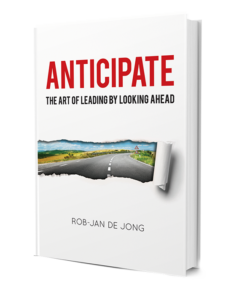Navigating Change
Studies show that the companies that navigate change well last the longest.
Why do some corporate leaders navigate through massive change while others seem oblivious to it?
How do you position your organization ahead of the trends?
Is it possible to learn to anticipate and prepare for the future?
Rob-Jan De Jong is a speaker, consultant and faculty member at Wharton’s executive program on Global Strategic Leadership. His new book, Anticipate: The Art of Leading by Looking Ahead, outlines what it takes to become a visionary leader. Sharing examples and principles from his research, Rob-Jan’s mission is to increase your personal visionary capacity. I recently had the opportunity to ask him about vision and the art of looking ahead.
3 Keys to Unleashing Vision at All Levels
As a CEO, I just loved this sentence: “Vision is not an exclusive for those in top ranked positions.” It’s really something for everyone, not only those with a title. How do corporate leaders unleash creativity and vision at all levels of the organization?
- Empowerment and trust.
An important success factor is around empowerment and trust. A directive company culture is detrimental for people’s engagement. Having a sense of influence is a prerequisite for getting people to become involved in the hard work of engaging with uncertainty and anticipating the future.
- Fault Tolerance.
A second critical factor is fault tolerance. This naturally goes with empowerment – people will get it right and every so often they will get it wrong. These are the important moments of truth for you as the leader, as your response will set the standard for the culture that shapes from these moments. People will be on the lookout about how serious you are about empowerment. My simple suggestion is to not focus on what went wrong but to focus on what the person has learned.
- Enabling Others.
And a third factor that should not be underestimated is that you will also need to enable your people to do this. Visioning, future engagement, anticipation is a skill set and a mindset. And it is often a step aside from the environment people have grown accustomed to, so you will need to enable your people to strengthen themselves in this area.
That might sound like blatant promotion for my work and my book, but I’m absolutely convinced that this has been a gap in management theory. Despite the widely acknowledged importance of ‘vision’ in leadership, little – if any – systematic support has been provided in terms of developing your visionary side as a leader in a responsible way. Scholars, business schools and strategy textbooks agree that a vision is one of the most powerful instruments a leader can have. And how you go about developing this side of your leadership has been met with tremendous silence.
It was my intention to fill part of this gap by offering a comprehensive perspective on the topic, original ideas, a developmental framework, various practices, and many stories and anecdotes to draw lessons from.
Learning to Be Visionary
Describing a true leader, almost all of us respond with the word “visionary.” Is it possible to learn to be more visionary?
My first reaction to this question is: absolutely. But the book has been described as an energetic, hype-free business guide – and I value the hype-free connotation in particular. The book has been put together with academic rigor, so I want to steer clear from overly optimistic responses. In reality, when working on your visionary capacity, you are surely facing a number of barriers. And some will take those easier than others.
But indeed, anyone can grow their visionary capacity. I like to compare it to sports, say tennis. Your tennis game is the result of your tennis skills, which in turn are the result of practice. Talent will help, but practice can get you a long way in improving your skills and thus improving your game of tennis. And our aim is not to become the next Roger Federer, but to significantly improve our game.
The same with vision. Your vision is the result of your visionary skills, and your visionary skills increase with applying the right practices. Surely, also here, some people are better at it than others, but here too, we’re not aiming to become a larger-than-life visionary, but we aim to get you to significantly up your game.
With the developmental framework I have created, and the two core skills I teach, which are around your ability to see change early and your ability to connect the dots, and with the associated practices, you will absolutely develop your visionary side very effectively to a higher level.
3 Ingredients of a Powerful Vision: Logos, Pathos & Ethos
Most leaders have evolved today in environments driven by market mantras. Its quarterly results orientation has left its marks on how they have grown used – and are often incentivized – to put short-term over long-term interests. The value of a vision, which is mostly concerned with the long term, has therefore depreciated. Some even make a mockery out of it, considering it something for dreamers and idealists, not for hard-nosed, results-oriented realists as they are. So “vision” has developed an image problem over time and that’s a real shame. Secondly, we must also admit that it is not easy. It’s not magic, but nor is it easy to do well.
Even those who do consciously work on it often arrive at results that are at best just “direction setting.” For a truly meaningful vision, that’s not enough. Direction setting is only one of three critical elements. For a “vision” to become powerful, it will need to be emotionally engaging: people need to feel something in order to persuade them. And thirdly, it needs to be credible and authentic, which implies people need to see it in how the leader behaves. Without authenticity, the vision is merely a set of hollow phrases, and it will equally fail to inspire.
Interestingly, we already knew this 2500 years ago. The Greek philosopher Aristotle already expressed what it takes to persuade people to follow. He drilled it down to 3 things: Logos, Pathos and Ethos.
 Logos really means that what you communicate should make sense, should be clear, logically consistent, and all these things we typically focus on. It’s important to get this right, but it is not enough. Your vision also needs to do something emotionally. People should feel something, your vision should have Pathos to remain in his words. That could be excitement or feeling intrigued or provoked through some unconventional elements, but it could equally be a feeling of warmth, caring and bonding through a deeply felt cause. And lastly, your vision should be credible coming from you, the leader. In other words, people need to be able to connect it to who you are, what you stand for, what you decided when you faced a dilemma, etc. This is what Aristotle labeled Ethos, the character of the speaker should align with the words. Your behavioral integrity is vital if you don’t want your vision to be mere hollow phrases. By the way, this is a problem we often see when reviewing company visions: nice words, slickly put together by a marketing department, but they lack credibility and are not enacted by the individuals. These visions are empty and do nothing that a powerful vision could provide: energy, inspiration and focused direction.
Logos really means that what you communicate should make sense, should be clear, logically consistent, and all these things we typically focus on. It’s important to get this right, but it is not enough. Your vision also needs to do something emotionally. People should feel something, your vision should have Pathos to remain in his words. That could be excitement or feeling intrigued or provoked through some unconventional elements, but it could equally be a feeling of warmth, caring and bonding through a deeply felt cause. And lastly, your vision should be credible coming from you, the leader. In other words, people need to be able to connect it to who you are, what you stand for, what you decided when you faced a dilemma, etc. This is what Aristotle labeled Ethos, the character of the speaker should align with the words. Your behavioral integrity is vital if you don’t want your vision to be mere hollow phrases. By the way, this is a problem we often see when reviewing company visions: nice words, slickly put together by a marketing department, but they lack credibility and are not enacted by the individuals. These visions are empty and do nothing that a powerful vision could provide: energy, inspiration and focused direction.
For Logos I’m usually not too concerned, that’s often the part we have well covered. People generally find it more challenging to integrate Pathos and Ethos into their vision. But there are straightforward ways to achieve that. For instance, the use of metaphors. Metaphors are images, and images help unlock people’s imagination, which is the state you want your audience to be in, in order to get them to open up to your imagined future. It should be no surprise that the word imagination is etymologically related to the word image. So pictorial language, metaphors and analogies can very effectively help you achieve that state.
Leaders Use Questions to Create Vision
How do questions help create vision?
Critical behavioral dimensions for your visionary side to blossom are curiosity, open-mindedness and a non-dogmatic attitude. Harvard’s Ellen Langer has written wonderfully about this in her standard work Mindfulness. Mind you, not the Buddhist Mindfulness you might be thinking of.
Anyway, these three aspects are supported and grown through the art of questioning. Challenging assumptions, being curious about other perspectives, are virtually always the roots for great visions to emerge. I write in Anticipate about a company called Solar Roadways. Started by a husband and wife with engineering backgrounds, they became frustrated with the fact that the world wasn’t coming up with any significant solutions to global warming. They developed the idea of building roads out of solar panels.
When I tell the story to people, often people begin to giggle. You can’t drive on a solar panel, they say. It’s too slippery, too expensive, too glary, etc. They have all sorts of immediate objections, but what’s really going on is that their mental models are resisting the idea that a solar panel can not only be placed on roofs, but could also be something to walk and drive on—with the appropriate glass texture of course.
When I tell them it already exists, they’re shocked. So an inquisitive, non-dogmatic mindset that embraces the art of questioning and embraces curiosity is an important area to explore if you want to up your visionary self. This is also why I delve into unlocking your imagination. Exploiting your imagination is crucial for visionary skills to grow. Simply because you are dealing with the future, you can’t work from proven facts, figures and experiences, since these are fundamentally past-oriented. As your vision concerns the future, tapping into your imagination is a must. So the ability to do so is part of the things I work on with clients and write about in the book.
Anticipate: The Art of Leading by Looking Ahead

